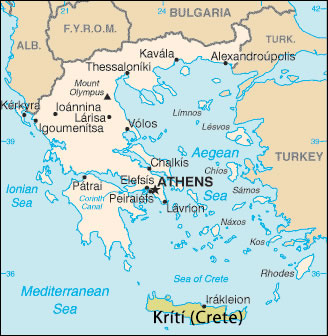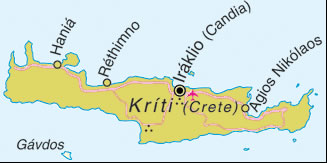Crete The Island, History, The People, Where to go
The Island
The island of Crete is the largest of the Greek islands, and the fifth largest in the Mediterranean Sea. Home to 650,000 people (as of 2005), the island is 260 km long and varies in width between 60 km and 12 km.
Crete is defined by a high mountain range crossing it from West to East, and enjoys over a thousand kilometres of coastline. The weather on Crete is usually mild, varying depending on altitude and proximity to the sea, and can be most enjoyed during the spring and autumn.
The main industry on the island is still agriculture, but there is a growing service sector, with tourism in particular booming along the coast and in the major cities.
History

The Island of Crete was home to one of the world's earliest civilisations, and Europe's earliest advanced civilisation, almost five thousand years ago. The Minoan civilisation arrived from North Africa circa 3000BC, utilising their knowledge of Bronze to become prosperous traders, producing excellent jewellery and pottery. At their height the civilisation was established in many of the Greek islands and had far reaching contact into the mainland, constructing magnificent multi-story palaces, the most famous of which is Knossos. The civilisation collapsed after a series of disasters- an earthquake circa 1600BC caused widespread destruction, and was followed by a massive volcanic explosion on the island of Thera, tearing it apart. This created a tsunami, destroying much of Cretian fleet, and allowed Mycenaeans from the mainland control of the island.
Crete later became an important trading centre under Greek settlement and, according to Homer, was home to more than a hundred cities including Cydonia (modern day Chaniá). These eventually began to fued, dividing the island into a number of combative city states, until Roman invasion in 71 BC. The island eventually fell after a ferocious three-year campaign in 69 BC.
After the split of the Roman Empire, Crete was ruled by the Byzantines until falling to the Arabs in AD 824, when Candia (now Heraklion), was made capital of the island. The island was reconquered for the Byzantines by Nicephorus Phocas (later Nicephorus II) in AD 961.
As a result of the Fourth Crusade, the island passed to Venice in AD 1204, who ruled for more than four hundred years, exposing Crete to Italian Rennaissance culture. Throughout this stage of history Crete was generally known as Candia (Iráklion), after the residence of the Venetian Duke who ruled the island.
Protests and violence against the arbitrary Venetians were frequent, and the Cretans were not displeased when the Ottoman Turks conquered the Island in AD 1669 after a twenty-four year war. The last two Venetian outposts on the Island, two offshore island fortresses, eventually fell in AD 1718.
Crete became embroiled in a war between Greece and Turkey in AD 1897, following a series of revolts against Turkish rule, ending after Turkey was forced to evacuate the island under pressure from England, France, Russia, and Italy in 1898.
The Republic of Crete became an autominous state after the war between Greece and Turkey, and proclaimed a union with Greece in 1908, and in 1912 Cretan representatives were admitted into the Greek parliament. Following the Balkan wars in 1913, Turkey relinquished all claim to the island, allowing Crete to be officially incorporated into Greece.
The British used Crete as a military and naval base late in 1940, and British and Greek forces on the Greek mainland evacuated their during 1941. These forces were quickly overwhelmed by the Germans in a large-scale airborne invasion, the first of its kind, leading to German occupation of the island. During the Autumn of 1944, British ships isolated the German troops, who eventually surrendered. (See links for more information).
The People
Section Under ConstructionWhere to go
Chania
Section under construction
Herkalion
Section under construction
Rethymon
Section under construction




